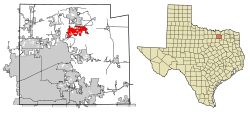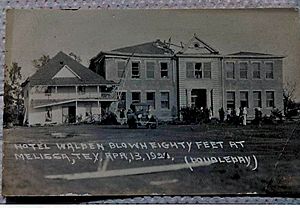Melissa, Texas facts for kids
Quick facts for kids
Melissa, Texas
|
|
|---|---|

Location of Melissa in Collin County, Texas
|
|
| Country | United States |
| State | Texas |
| County | Collin |
| Area | |
| • Total | 11.52 sq mi (29.83 km2) |
| • Land | 11.45 sq mi (29.66 km2) |
| • Water | 0.07 sq mi (0.17 km2) |
| Elevation | 656 ft (200 m) |
| Population
(2020)
|
|
| • Total | 13,901 |
| • Density | 1,058.07/sq mi (408.52/km2) |
| Time zone | UTC-6 (Central (CST)) |
| • Summer (DST) | UTC-5 (CDT) |
| ZIP codes |
75071, 75454
|
| Area code(s) | 972 |
| FIPS code | 48-47496 |
| GNIS feature ID | 2411073 |
Melissa is a city located in Collin County, Texas, United States. It's a growing city! In 2010, about 4,695 people lived there. By 2020, the population had grown a lot, reaching 13,901 people.
Contents
History of Melissa
Early Settlers and Native Americans
Long ago, Melissa was home to some of the very first people in North America, called Paleo-Indians. Evidence shows they lived there around 9500 BC. Over many centuries, different Native American tribes also lived in the area. These included the Caddo, Cherokee, Delaware, Kickapoo, and Tonkawa peoples.
They lived peacefully, focusing on farming, hunting, and gathering food from the land. The Tonkawa people even had a settlement northeast of McKinney.
Founding of the Town
The first modern settlers came from a community called Highland, which was a few miles north of where Melissa is today. A blacksmith named C.H. Wysong was one of the first to settle there. A post office was set up in Highland in 1853.
The Houston and Texas Central Railroad arrived in Melissa in 1872. They built a train station, which helped the town grow. Many families moved to Melissa because of the railroad.
The town is thought to be named after Melissa, the daughter of George A. Quinlan, a railroad executive. However, some people believe it was named after Melissa Huntington, another railroad executive's daughter. Interestingly, the nearby town of Anna, Texas is named after Anna Elizabeth Quinlan, George Austin Quinlan's only daughter.
Schools and Growth
The first school in Melissa was built on land bought in 1882. The first teacher was Mary Huckerston, who taught 38 students for five years. Church services for all faiths were also held there on Sundays. As the town grew, a new, bigger brick schoolhouse was built on the same spot in 1910.
In the early 1900s, Melissa was an important place for shipping goods by train. Farmers sent corn, wheat, alfalfa hay, wood, and even livestock (farm animals) from Melissa to other places.
Challenges and Rebuilding
Melissa faced a big challenge on April 13, 1921, when a very strong F4 tornado hit the town. It was a terrible storm that killed 13 people and injured many more. The tornado ripped the roof off the brick school building, but luckily, the children inside were not seriously hurt.
However, all the churches, three cotton gins (machines that separate cotton fibers), and almost every business were destroyed. Only a bank, the post office, and the train station were left standing. The Waldon Hotel was even lifted by the wind and thrown against the school building!
Eight years later, on August 8, 1929, another disaster struck. A fire burned down many of the buildings that had been rebuilt after the tornado. Because of these events, the number of people living in Melissa went down. It dropped from about 500 people in 1925 to 285 in 1949.
Geography
Melissa is located in the northern part of Collin County, Texas. Several important roads pass through or near the city. State Highway 5 goes through the middle of Melissa. State Highway 121 is in the eastern part, and the U.S. Route 75 freeway is on the western side.
US 75 and Highway 121 meet in the southwest part of Melissa. From there, they head about 6 miles (10 km) southwest to McKinney, which is the main city of Collin County. The big city of Dallas is about 40 miles (64 km) southwest of Melissa. Denison is about 37 miles (60 km) north if you take US 75.
The United States Census Bureau says that Melissa covers a total area of about 11.52 square miles (29.83 km²). Most of this area, about 11.45 square miles (29.66 km²), is land. A small part, about 0.07 square miles (0.17 km²), is water.
Demographics
| Historical population | |||
|---|---|---|---|
| Census | Pop. | %± | |
| 1880 | 57 | — | |
| 1960 | 405 | — | |
| 1980 | 604 | — | |
| 1990 | 557 | −7.8% | |
| 2000 | 1,350 | 142.4% | |
| 2010 | 4,695 | 247.8% | |
| 2020 | 13,901 | 196.1% | |
| 2023 (est.) | 23,571 | 402.0% | |
The population of Melissa has grown a lot over the years. You can see how much it has changed in the table below.
| Race | Number | Percentage |
|---|---|---|
| White (NH) | 8,926 | 64.21% |
| Black or African American (NH) | 1,552 | 11.16% |
| Native American or Alaska Native (NH) | 118 | 0.85% |
| Asian (NH) | 475 | 3.42% |
| Pacific Islander (NH) | 10 | 0.07% |
| Some Other Race (NH) | 62 | 0.45% |
| Mixed/Multi-Racial (NH) | 761 | 5.47% |
| Hispanic or Latino | 1,997 | 14.37% |
| Total | 13,901 |
In 2020, there were 13,901 people living in Melissa. There were 3,058 households, and 2,824 families. Back in 2000, there were 1,350 people, 472 households, and 365 families.
In 2000, about 38.8% of households had children under 18 living with them. Most households (69.5%) were married couples living together. About 18.6% of all households were made up of single individuals.
The average age of people in Melissa in 2000 was 35 years old. About 30.8% of the population was under 18 years old. In 2000, the average income for a household in Melissa was about $60,909 per year. For families, the average income was about $66,172.
Education
The city of Melissa is served by the Melissa Independent School District. This school district is responsible for educating the children in the area.
In 2004, the school districts of McKinney and Anna decided they could no longer teach high school students from Melissa. So, in 2007, Melissa High School had its very first graduating class, with 46 students.
In 2008, Harry McKillop Elementary School opened. It taught students from Pre-Kindergarten to third grade. The old Melissa Ridge Elementary School campus was then changed into two new schools:
- Melissa Ridge Intermediate School, for fourth and fifth graders.
- Melissa Middle School, for sixth, seventh, and eighth graders.
In 2015, Melissa Middle School received a special award, being named "A School to Watch." This means it's recognized as one of the top schools in Texas.
In 2019, the Melissa Schools changed how their campuses were organized again:
- Melissa Ridge Education Center now serves Pre-Kindergarten through Kindergarten.
- Harry McKillop Elementary School serves grades 1–5.
- North Creek Elementary School also serves grades 1–5.
- Melissa Middle School continues to serve grades 6–8.
- Melissa High School serves grades 9–12.
See also
 In Spanish: Melissa (Texas) para niños
In Spanish: Melissa (Texas) para niños


